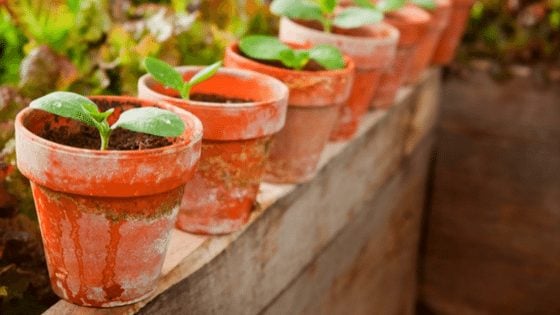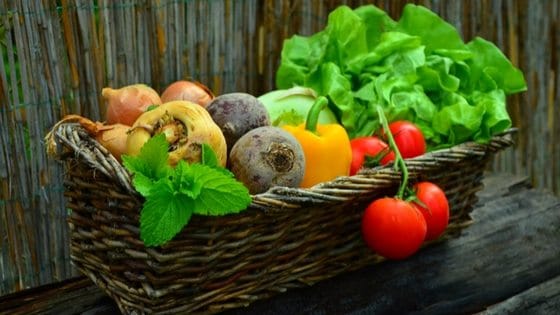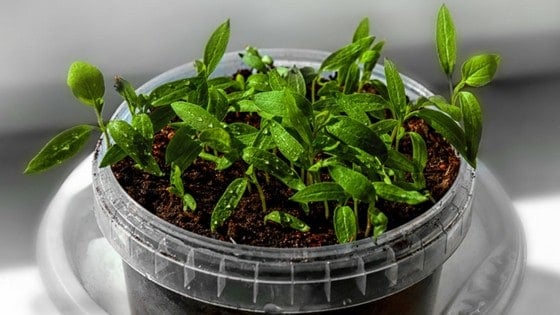Whether you have apple trees growing right on your own property or you just scored a killer deal on a bushel at your favorite farmstand, knowing how to preserve apples is an essential skill.
An apple a day keeps the doctor away – but for most people, apples are hard to come by during the winter months!
Therefore, it’s important to be aware of all of the different methods of preserving apples so that you can have these tasty, nutritious staples on hand at all times.
Here are some of the best strategies so that you can try your own hand at preserving apples this year!
Table of Contents (Quickly Jump To Information)
Storing Apples
Many people don’t bother with any other methods of preserving apples because these fruits are so easy to store. Apples hold up well in a root cellar or another method of cold storage – you won’t have to do anything except put them in a wooden crate in a cold, dark location.
When provided with the proper conditions (usually, temperatures above freezing but less than 55 degrees), apples will last for several months to a year in root cellars or cold storage.
Canning Apples
There are several different ways you can preserve apples by canning, either by canning them whole or in slices. You can add sugar or not – the choice is up to you. Here’s a good recipe for canning apples that you should know about.
Make Applesauce
If you decide to preserve your apples by making applesauce, don’t worry – you don’t have to peel and cut them if you don’t want to. Instead, you can steam your apples and then process them by running them through a sieve. This will catch all the peelings and seeds.
Once your applesauce is complete, you can always can it in a water bath canner. That way, you’ll have plenty of applesauce to last you all season. Alternatively, you can just stash it in the freezer.
Make Apple Butter
Making apple butter is a classic method of preserving apples. It goes nicely on bread and pancakes, and it’s pretty easy to make. Here are some instructions for you to follow.
Whip Up Some Apple Pie Filling
If you like baking apple pies, you no doubt know the frustration that arises when you are preparing to make a pie and alas…find that you have no apples in the pantry. Preserving apples by whipping up some apple pie filling is the best way to prevent this tragedy!
Or, you know…you can always eat the apple pie filling out of a jar with a spoon!
To do this, whip up your favorite apple pie recipe as you normally would, combining about 12 cups of apples, 2 ¾ cups of sugar, ¾ cup of Clear Jel, and your favorite spices. You will need to can the filling in a water bath canner, but if you don’t want to go through all the hassle of canning it, you can just store it in the refrigerator or freezer instead.
Make Apple Jelly
Apple jelly is another classic recipe for preserving apples. Did you know that you can make it with just two ingredients -apples and some natural sugar?
Here’s a recipe for making apple jelly. You’ll love how it tastes, plus, it will last for years in storage.
Freeze Your Apples
You can easily freeze whole or sliced apples to be used later on in baking – or eaten as is. You can freeze them by themselves or with a bit of added sugar.
To do this, wash, peel, and core your apples. Add ½ tsp of ascorbic acid if you are worried about browning. Then, place your apples in freezer-safe containers, making sure you label and date them.
If you want to prevent your apples from sticking together, you can always flash freeze them first, leaving space between each piece as you freeze them on a tray. Once the slices have frozen, usually within three hours, you can pack them into a container and not have to worry about them clumping together. Frozen apples last about a year in storage.
Freeze Apples in Syrup
If you want to have some apples in syrup around for a quick snack later on, this is the perfect way to do it. All you need to do is dissolve 2 ½ cups of sugar in 4 cups of warm water, mixing until you have a clear solution. Then, you’ll pour the syrup over your washed and sliced apples, adding a bit of ascorbic acid powder to prevent the apples from browning.
You can put the mixture into containers, adding just enough syrup to cover the apples and leaving about ½ inch of headspace. That’s all there is to it!
Make Apple Pectin
Like to can? You can make your own pectin with apples! Apples are high in pectin and a DIY apple pectin can be used in all of your own canning recipes for jam and jelly. This is why you don’t need to add any extra pectin in the apple jelly recipe we mentioned above.
Make an Apple Chutney
Apple chutney is a classic recipe, with chutneys of all kinds hailing back to origins in India. Usually eaten in small amounts, chutney has a ton of flavor and can easily be made with your own harvested apples. Here’s a recipe for you to try.
DIY Apple Cider Vinegar
You can even make your own apple cider vinegar at home! Apple cider vinegar is not only shelf-stable, making good use out of all of your apples, but it also has a ton of practical uses on the homestead.
Apple cider vinegar can be used for everything from sanitizing chicken waterers to providing a boost of probiotics to sick sheep. It’s also a great natural home cleaning agent and a fantastic cure for a sore throat.
To make your own apple cider vinegar, you will need to ferment it. Here’s a tutorial on how to do it.
Brew Up Some Apple Juice
Must-try recipe if you have children, apple juice is really easy to make on your own. You’ll need about 18 apples to produce 8 servings of juice, along with sugar (if you choose) and cinnamon.
To begin, wash and core your apples to remove the seeds. Cut the apples into slices and don’t worry about peeling them. Add them to a pot and add enough water to cover them – avoid adding too much water, as this can dilute the juice.
Boil the apples for 20 minutes. Strain out the apples and leave behind the apple mush. Repeat the process until all of your juice has been extracted.
Make Apple Cider
You can make your own apple cider – either hard or not – with all of your extra apples, too! To do this, you will only need some apples, cinnamon sticks, sugar, and water. You’ll also need some cheesecloth and a strainer.
After combining your ingredients, you’ll boil them, eventually mashing your apples and spices to a pulp. The cheesecloth will be used to help you strain out the rest of the juice from the brew.
Make Apple Syrup
Just as maple syrup tastes great on your pancakes, so does apple syrup! To make your own apple syrup, all you need to do is combine 1 tbsp cornstarch, ¼ tsp each of cinnamon and nutmeg, and 1 ¼ cups apple juice. You can add sugar, too, to taste. Boil them in a saucepan until they reach a sticky, syrupy consistency, then serve over pancakes, waffles, or Frech toast.
Ferment Your Apples
Did you know you can even ferment apples? You’ll add apples, some spices, and culture starter water to a quart-size mason jar, stirring together your ingredients until everything is evenly distributed. You will need to use a fermentation weight to keep the apples submerged under the brine.
The entire process of fermentation takes about three to six weeks, depending on the temperature and yeast content of the brew. The final fermented apples will be packed with probiotics – and loaded with flavor.
Dehydrated Apples – With or Without Cinnamon
Dehydrated apples are super easy to make. All you need to do is slice your apples into thin slices, doing your best to slice them at uniform thicknesses. This will help them dry evenly so you don’t have to worry about some being dryer and crispier than others!
After slicing your apples (you may want to place them in lemon juice while you are working on the rest), you can place them in your dehydrator. If you want, you can even add a few tablespoons of ground cinnamon on the slices to give them a nice flavor. This will also prevent premature browning so you can eliminate the lemon juice!
Once you have all of your slices ready, put them in the dehydrator, making sure you leave space between each slice for airflow. Set the dehydrator to 135 degrees Fahrenheit and then dehydrate the apples until they are completely dry. Most of the time, this will take anywhere from six to 24 hours to do.
After your apples have finished dehydrating, you can store them in a sealed container. They’ll last practically forever!
Make Fruit Leather
If you were a kid, you likely loved the taste of storebought Fruit Roll-Ups. But you don’t have to be a kid to enjoy these homemade apple fruit leathers! They’re easy to make – all you have to do is puree the apple and combine it with another fruit or nut butter (like Nutella) of your choosing.
Then, you’ll dehydrate the mixture for four or five hours in your food dehydrator. That’s all there is to it!
Leave Them Right on the Tree
In some cases, the best way of preserving apples is to leave them right on the tree! If you live in a mild climate, you can’t wait to harvest your apples until early November and then hang them in cloth bags on the tree.
If you live somewhere in which you don’t receive a ton of cold weather or precipitation during the winter months, storing your apples right on the tree is a great way to keep them cold and moist. The cloth bags provide adequate airflow, and you usually can store apples in this way well into winter.
Don’t let all of your apples go to waste! Apples are loaded with nutrients and have so many uses in the kitchen. Consider trying out one of these methods of preserving apples instead.
Maat van Uitert is a backyard chicken and sustainable living expert. She is also the author of Chickens: Naturally Raising A Sustainable Flock, which was a best seller in it’s Amazon category. Maat has been featured on NBC, CBS, AOL Finance, Community Chickens, the Huffington Post, Chickens magazine, Backyard Poultry, and Countryside Magazine. She lives on her farm in Southeast Missouri with her husband, two children, and about a million chickens and ducks. You can follow Maat on Facebook here and Instagram here.






